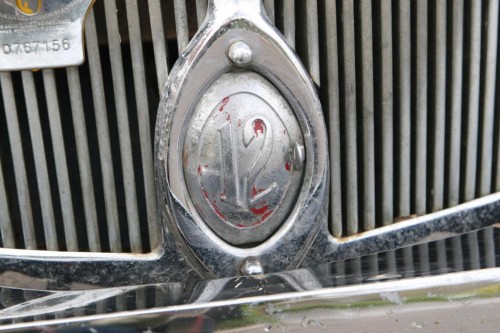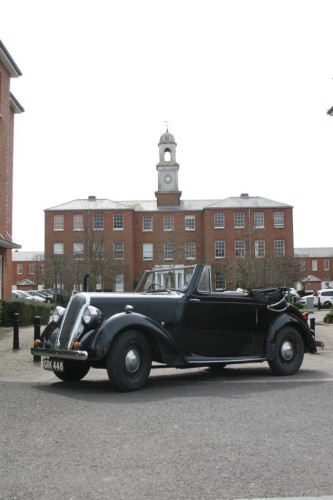 If, like me, you find cars just as interesting as artefacts of their time than as things to drive around in in 2013, then the subject of this week’s road test is a doozy. For everyone else, may I suggest you return outdoors and soak up some of the precious evening sunlight that we’re enjoying at the moment.
If, like me, you find cars just as interesting as artefacts of their time than as things to drive around in in 2013, then the subject of this week’s road test is a doozy. For everyone else, may I suggest you return outdoors and soak up some of the precious evening sunlight that we’re enjoying at the moment.
The immediate post-war period is often overlooked in motoring history, mainly because not a lot happened. With all of Britain’s car factories turned over to making machines of war and with large parts of the Midlands flattened by bombing, the industry wasn’t in any state to spring immediately back to action. No new development or research for civilian cars had been going on during the war years and, in any case, petrol was still tightly rationed, disposable income was virtually nil and a good chunk of the population were in the Forces mopping up the aftermath of a little tiff with the Axis powers .
This meant that Britain’s car makers simply dusted off their old pre-war designs, cheapened them a bit to suit the new mantra of cost-cutting and austerity (imagine such a thing these days!) and stuck them in the showrooms while they frantically busied themselves with making properly new cars.
The result would be the raft of new (and often groundbreaking) models launched at the 1948 London Motor Show (the Morris Minor, the Austin ‘County’ series, the Land Rover, the Jaguar XK120 and, last and definitely least, the Vauxhall Wyvern). Until then the fortunate British person able to contemplate buying a new car was faced with a distinctly depressing choice.
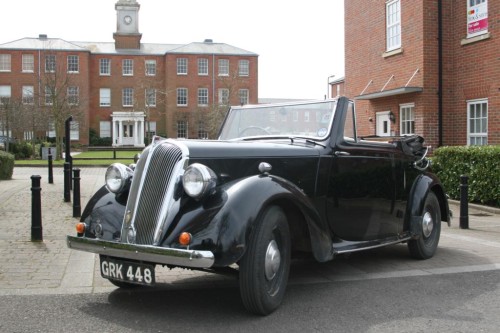 It is one of those cars that we are considering here, in the form of a 1948 Standard Twelve Coupé. This is a lightly fettled (read- ‘significantly down-specced’) version of the pre-war ‘Flying Twelve’. Although entirely vanished from the public consciousness these days from the ‘Thirties to the ‘Fifties Standard was a staple of the British motor industry, offering entirely unremarkable but solidly-built and well-designed cars for the middle parts of the market. It had spent the war years doing the usual thing of making aero engines and bits for tanks, as well as thousands of the ubiquitous ‘tilly’ light trucks based on the Flying Twelve and even a rather desperate light tank based on the Fourteen (same car but a slightly bigger engine) for the Home Guard to use in the event of an invasion. As soon as the war ended Standard snapped up the car-making side of Triumph, which had gone bust in 1939, thus setting that marquee on its course to greater glories. Standard also provided the running gear for a sports car called the ‘Jaguar’ built by a little outfit called the Swallow Sidecar Company (whatever became of them?), and used part of its huge wartime ‘shadow factory’ to build the groundbreaking Ferguson TE-20 tractor. Standard’s influence on the car industry lingered long after the company itself had disappeared.
It is one of those cars that we are considering here, in the form of a 1948 Standard Twelve Coupé. This is a lightly fettled (read- ‘significantly down-specced’) version of the pre-war ‘Flying Twelve’. Although entirely vanished from the public consciousness these days from the ‘Thirties to the ‘Fifties Standard was a staple of the British motor industry, offering entirely unremarkable but solidly-built and well-designed cars for the middle parts of the market. It had spent the war years doing the usual thing of making aero engines and bits for tanks, as well as thousands of the ubiquitous ‘tilly’ light trucks based on the Flying Twelve and even a rather desperate light tank based on the Fourteen (same car but a slightly bigger engine) for the Home Guard to use in the event of an invasion. As soon as the war ended Standard snapped up the car-making side of Triumph, which had gone bust in 1939, thus setting that marquee on its course to greater glories. Standard also provided the running gear for a sports car called the ‘Jaguar’ built by a little outfit called the Swallow Sidecar Company (whatever became of them?), and used part of its huge wartime ‘shadow factory’ to build the groundbreaking Ferguson TE-20 tractor. Standard’s influence on the car industry lingered long after the company itself had disappeared.
All that was in the future when this Twelve Coupé rolled off the line in Coventry, though. Instead it provides a rare example of this strange purgatory period for the British car industry and the British car buyer.
Outside
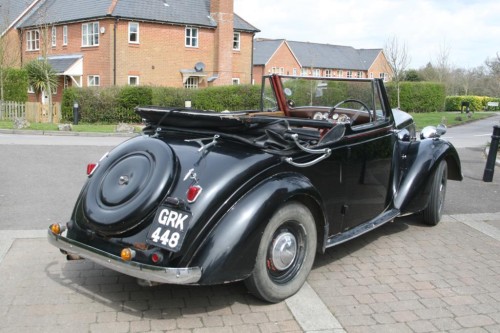 People who complain that ‘all cars look the same’ these days have clearly never looked at what was offer in the ‘Thirties or mid-‘Forties. With the exception of some high-cost exotica (and the Morris 8 Series E) every car was essentially identical apart from the grille, with the same styling being scaled as required. The range of ‘Flying’ Standards introduced the distinctive ‘waterfall’ grille with curved vertical chrome strips topped by a bonnet ornament showing a Union Flag pennant streaming back in the wind (hence the ‘Flying’ moniker on the early cars). Apart from that it’s the same broad, high wings with large separate Lucas headlamps, vestigial running boards, suicide doors, a flat bonnet with double-leaf opening sections, a flat windscreen and a tapering boot with an external spare wheel mounted under a neat metal cover.
People who complain that ‘all cars look the same’ these days have clearly never looked at what was offer in the ‘Thirties or mid-‘Forties. With the exception of some high-cost exotica (and the Morris 8 Series E) every car was essentially identical apart from the grille, with the same styling being scaled as required. The range of ‘Flying’ Standards introduced the distinctive ‘waterfall’ grille with curved vertical chrome strips topped by a bonnet ornament showing a Union Flag pennant streaming back in the wind (hence the ‘Flying’ moniker on the early cars). Apart from that it’s the same broad, high wings with large separate Lucas headlamps, vestigial running boards, suicide doors, a flat bonnet with double-leaf opening sections, a flat windscreen and a tapering boot with an external spare wheel mounted under a neat metal cover.
Standard cognoscenti will recognise this car as a post-war model by the lack of several features- this car lacks the chromed air louvers in the bonnet, the spoked ‘artillery’ wheels and the volute-scrolled bumpers of the genuine ‘Flying’ Twelve. All panels and ornaments are plainer which, in a strange way, help the car look more modern and less ‘fussy’ than it would do if it was built in the ‘Thirties’. In keeping with a world forever passed down in black and white film, the Twelve was only available in black or grey (the pre-war colour palette was slightly broader). This one if former, although a red coach line does a little to relieve the tedium.
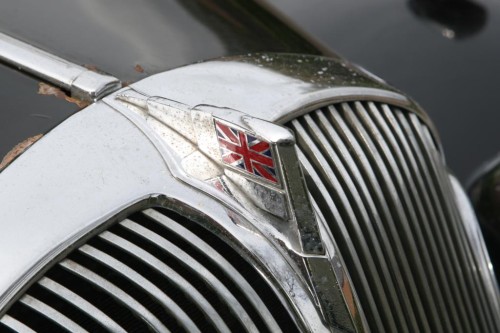 There are some things that do look dated though- the hood is braced at the rear by external chromed S-struts which look like something off a Royal Mail Stagecoach or an Edwardian pram. Despite the best efforts of the grille’s stylists the car’s profile is undeniably upright and square-rigged. It shows wonderfully how far the trends in car styling have come in 70-odd years- the Twelve is narrow, tall, on plain steel wheels with slim, high-profile tyres and has no ‘stance’ at all in the modern sense.
There are some things that do look dated though- the hood is braced at the rear by external chromed S-struts which look like something off a Royal Mail Stagecoach or an Edwardian pram. Despite the best efforts of the grille’s stylists the car’s profile is undeniably upright and square-rigged. It shows wonderfully how far the trends in car styling have come in 70-odd years- the Twelve is narrow, tall, on plain steel wheels with slim, high-profile tyres and has no ‘stance’ at all in the modern sense.
Inside
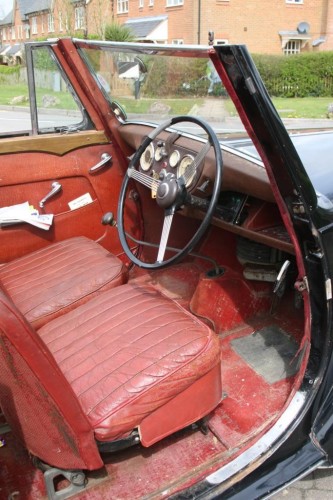 Anyone familiar with cars of this period will find nothing surprising about the Twelve’s interior. The interior is trimmed in red/orange leather, resembling the material used for a squishy sofa in a pub snug. The 1948 Standard Cars brochure warned that ‘due to a world shortage of supplies, quality cloth trim may be substituted for leather at any time without notice’ . Clearly this car escaped the Great Cow Shortage of 1948. The seat and door-trim material is matched by colour-coded carpets in that strange bristly carpet stuff that only seemed to exist in the ‘Forties- it looks like it’s been woven from dozens of pillaged nail brushes. The dashboard itself is made from a single piece of Bakelite (what’s the term for a piece of Bakelite- casting? pressing? Moulding? Whatever…) with the gauges grouped in the middle.
Anyone familiar with cars of this period will find nothing surprising about the Twelve’s interior. The interior is trimmed in red/orange leather, resembling the material used for a squishy sofa in a pub snug. The 1948 Standard Cars brochure warned that ‘due to a world shortage of supplies, quality cloth trim may be substituted for leather at any time without notice’ . Clearly this car escaped the Great Cow Shortage of 1948. The seat and door-trim material is matched by colour-coded carpets in that strange bristly carpet stuff that only seemed to exist in the ‘Forties- it looks like it’s been woven from dozens of pillaged nail brushes. The dashboard itself is made from a single piece of Bakelite (what’s the term for a piece of Bakelite- casting? pressing? Moulding? Whatever…) with the gauges grouped in the middle.
No surprises with instrumentation either, as they’re the usual brown-on-beige Smiths affairs, consisting of a speedometer (reading to the unlikely top speed of 80mph, with a telltale marker at a much more likely 30), an ammeter, a clock (electrically powered…!) and then a tri-gauge showing water temperature, fuel quantity and oil pressure (the latter two in good, solid, dependable gallons and PSI, but the temperature is measured in Celsius). There’s a rotary switch for the headlamps combined with the ignition key.
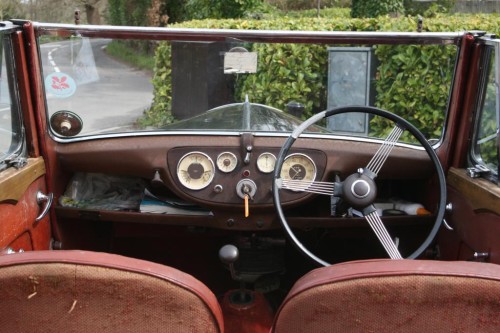 That’s pretty much it- there are choke and starter knobs under the dials and a small rheostat dial to adjust the speed of the aftermarket Smith ‘shin burner’ recirculating heater that’s been crammed into the footwell and not much else. The only other thing worth mentioning are the two big manual knobs, one for each windscreen wiper. To start the wipers you have to push the knob inwards and manually sweep the wiper through its arc a couple of times until the electric motor kicks in with a tediously slow motion.
That’s pretty much it- there are choke and starter knobs under the dials and a small rheostat dial to adjust the speed of the aftermarket Smith ‘shin burner’ recirculating heater that’s been crammed into the footwell and not much else. The only other thing worth mentioning are the two big manual knobs, one for each windscreen wiper. To start the wipers you have to push the knob inwards and manually sweep the wiper through its arc a couple of times until the electric motor kicks in with a tediously slow motion.
Under Way
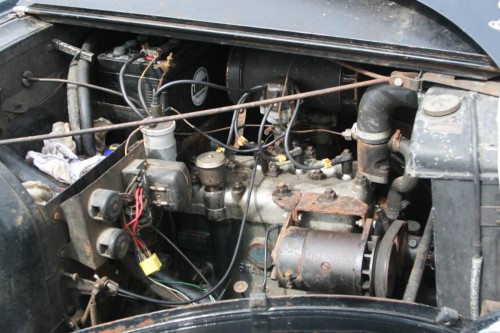 Fortunately the motor under the Twelve’s bonnet is much easier to get going. Turn the key on, pull out the choke (or ‘Easy Start Device’ as Standard calls it), open the throttle a little and pull the starter. The sidevalve engine catches almost instantly with a loud whirr from the Bendix starter which is replaced by the smooth, refined swish-whirr-swish-whirr-swish of a properly set-up petrol engine. All you can hear at idle is the click of the distributor drive, a hum from the dynamo bearings, a bit of fan noise and a slight hiss from the single Zenith down-draught carburretor.
Fortunately the motor under the Twelve’s bonnet is much easier to get going. Turn the key on, pull out the choke (or ‘Easy Start Device’ as Standard calls it), open the throttle a little and pull the starter. The sidevalve engine catches almost instantly with a loud whirr from the Bendix starter which is replaced by the smooth, refined swish-whirr-swish-whirr-swish of a properly set-up petrol engine. All you can hear at idle is the click of the distributor drive, a hum from the dynamo bearings, a bit of fan noise and a slight hiss from the single Zenith down-draught carburretor.
The four-speed gearbox isn’t slick but, because the big cranked gearlever (topped with a lovely machine-lathed piece of real wood) feeds directly into the selectors it is wonderfully tactile. It may need to be virtually karate-chopped into first gear but you can feel every detent, fork and selector ring moving around.
With the long stroke that was characteristic of British car engines in the days of RAC horsepower the Twelve’s 1.6-litre 4-cylinder motor delivers strong torque at low speeds at the expense of a distinct disinclination to rev. What the engine is is a slogger- it is happy pulling against high gears at the bottom part of its range and once you realise that you basically have to treat it like a modern turbodiesel and change into the high gears as soon as possible while making full use of the throttle you can make respectable progress. Of course modern fuel (with a lead replacement and octane boost additive) is far superior to the indifferent ‘pool petrol’ that was available when the car was new, so unlike the driver from 1948 you don’t have to worry about knock and pinking when you work the engine in this way.
The gearbox never likes being rushed, and with synchromesh only present on third and fourth you don’t want to rush it. It takes a firm, deliberate action to navigate the notchy gate and it’s a case of double de-clutching down the ‘box one gear at a time when slowing down (with a bit of heel-and-toe if needed) and then (somehow) ‘forcefully easing’ your way into each ratio when accelerating.
Performance
The 12 RAC horsepower translates to around 50 brake horses, so the Twelve is never going to be rapid. To call it anything other than ‘direly slow’ by any modern standards would be utterly false, but when you’re dealing with a 65-year old car this is a complete irrelevance anyway. The Standard isn’t driven with power, but with torque and managing it and maintaining momentum once you have it, is the key to making smooth progress. For all of its disinclination to rev the engine never feels particularly strained. The Standard will clip along nicely at 60mph, with the speedo needle flapping wildling between 55 and 65, while feeling that it has potential to go faster.
These bald statements can’t really do justice to how much you wouldn’t want to go faster, though. Which brings me onto:
Ride and Handling
If you’ve never quite understood how the Morris Minor could ever be considered a ‘driving revelation’, you need to drive a car from the previous era. Like this one.
With a separate chassis, a transverse leaf-sprung front axle providing ‘independent’ suspension via lever-arm dampers with a live axle and more leaf-springs at the back the Standard Twelve essentially has no dynamic qualities whatsoever. It is a ‘driver’s car’ only in the sense that it requires constant attention and action on the part of the driver to keep it proceeding in vaguely the right direction.
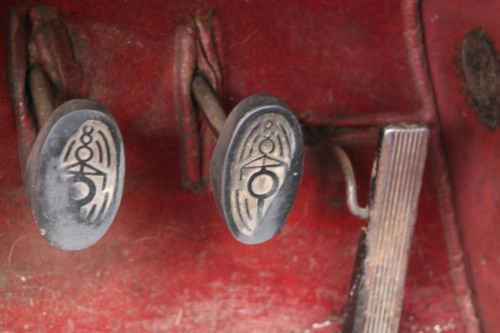 Let’s start with a good point- the ride comfort itself is excellent. Those leaf springs, coupled to the squidgy cross-ply tyres, are very effective at soaking up potholes and bumps and the car never jars or crashes over irregularities in the road surface. Given its layout it is remarkably free from bump-steer and ‘shuffle’, too.
Let’s start with a good point- the ride comfort itself is excellent. Those leaf springs, coupled to the squidgy cross-ply tyres, are very effective at soaking up potholes and bumps and the car never jars or crashes over irregularities in the road surface. Given its layout it is remarkably free from bump-steer and ‘shuffle’, too.
I think both of these qualities may be because the entire structure of the car is so limp that the chassis itself flexes and folds as it goes along, as if it were one huge down-filled mattress cushioning the shocks. This car suffers from the bête noir of all convertibles derived from saloons- that chopping the roof off removes a great deal of the structural rigidity of the car. If you’ve always thought that the term ‘scuttle shake’ was a largely theoretical thing, then drive an old drop-top car. On the Standard you can see literally an inch of movement fore/aft between the leading edge of the door and the windscreen pillar (admittedly this is a combination of genuine scuttle shake and slack in the door hinges), and effect made even worse if you decide to crank open the windscreen for extra ventilation. Incidentally this doesn’t open enough to provide ‘wind in the hair’ but just enough to provide ‘bugs in the teeth’.
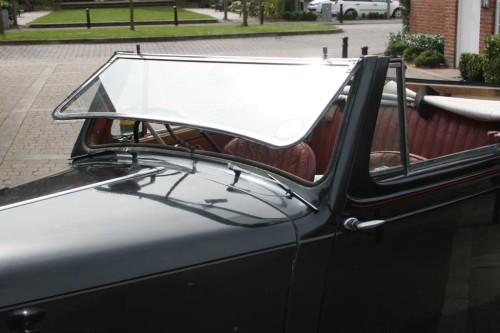 While the suspension may be surprisingly good at tackling larger obstacles, the Standard’s bodywork fidgets and rattles continuously as it goes along. The affectionate term used by aviators for several old aircraft types- ‘a collection of parts flying in loose formation’- has never been more apt for a car. When confronted with an obstacle that town planners hadn’t though up in 1948, like a mini roundabout or a traffic calming chicane, the Twelve displays true Blitz Spirit and plunges gamely on, feeling for all the world like the chassis and running gear are steering around the traffic island while the bodywork ploughs straight on to meet up on the other side.
While the suspension may be surprisingly good at tackling larger obstacles, the Standard’s bodywork fidgets and rattles continuously as it goes along. The affectionate term used by aviators for several old aircraft types- ‘a collection of parts flying in loose formation’- has never been more apt for a car. When confronted with an obstacle that town planners hadn’t though up in 1948, like a mini roundabout or a traffic calming chicane, the Twelve displays true Blitz Spirit and plunges gamely on, feeling for all the world like the chassis and running gear are steering around the traffic island while the bodywork ploughs straight on to meet up on the other side.
You know those old American films with in-car scenes, where the view out the rear screen is a badly-projected piece of stock footage? I bet you thought the exaggerated, constant wheel movements were just bad acting. Well, they’re not. The Standard Twelve uses recirculating ball steering box and a forest of link arms and track rods to make the front wheel swivel around a pair of kingpins. This is not going to produce a quick or responsive steering system. Granted, after six decades this car has some significant wear in the lower bush of the steering box that needs to be taken up but there is a good two inches of play around the big three-spoked wheel’s centre point before anything starts to happen. Even then given the general limp nature of the Twelve’s structure the steering is rarely more than a suggestive instrument, rather like pulling on the reins of a horse. You can make the car go ‘left’ and you can make it go ‘right’ and that’s pretty much it.
On straight roads you adopt the Highway Code-mandated ‘wheel shuffle’ between hands to keep the car in lane as it flounces along. Corners require constant correction and recorrection as you go round, like a sailing yacht luffing up to an unpredictable breeze. The Standard can deal with one aspect of handling at a time without problem, but show it a corner with camber, or a corner with camber and an awkward bump at the apex, and it doesn’t really know what to do. All you can do is frantically wind away at the wheel and see if it sorts itself out.
It always does, of course. It is the complete lack of any real feedback or finesse to any of the controls that make the Twelve such a bizarre and physical driving experience. It would be daft to say that it doesn’t communicate anything to the driver- such a basic, all-mechanical car can do nothing else- but it’s as if every component and system is shouting at once, so you can never pick out one particular part of the experience.
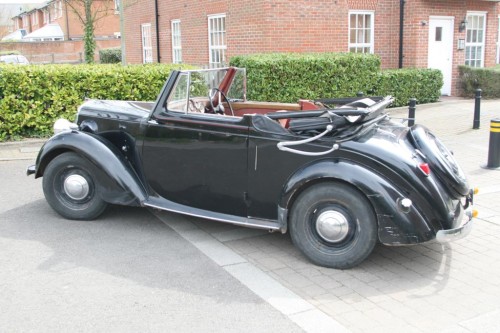 The brakes are a good example. Standard described them as ‘very powerful’, but not what this was in relation to. The braking system consists of drums all-round, operated by cables actuated by the single brake pedal. The handbrake simply acts on the master cable, applying the brakes on all four wheels and leaving the pedal ‘dead’. The result is that all slowing actions need to be done well ahead of time. The brakes are perfectly adequate for the weight of the car and the speeds it can reach, but no better than that. Part of the problem is that they are ‘self servoing’, a design where the shape of the brake shoes mean that as they are applied the brake drum grabs the leading part of the shoe and forces it against the drum, applying more braking effort, which forces more of the shoe against the drum and so on. This means that the brakes need a very firm press before they start to bite, then they will gradually bite harder even if you don’t push on the pedal any more, until the system reaches an equilibrium. The design also means that the brakes will work harder if you quickly stamp on the pedal rather then gently depressing it. A full on ‘emergency stop’ can actually lock all four wheels, but with no hydraulics to provide feedback it is initially very hard to judge exactly what the right amount of pedal travel is.
The brakes are a good example. Standard described them as ‘very powerful’, but not what this was in relation to. The braking system consists of drums all-round, operated by cables actuated by the single brake pedal. The handbrake simply acts on the master cable, applying the brakes on all four wheels and leaving the pedal ‘dead’. The result is that all slowing actions need to be done well ahead of time. The brakes are perfectly adequate for the weight of the car and the speeds it can reach, but no better than that. Part of the problem is that they are ‘self servoing’, a design where the shape of the brake shoes mean that as they are applied the brake drum grabs the leading part of the shoe and forces it against the drum, applying more braking effort, which forces more of the shoe against the drum and so on. This means that the brakes need a very firm press before they start to bite, then they will gradually bite harder even if you don’t push on the pedal any more, until the system reaches an equilibrium. The design also means that the brakes will work harder if you quickly stamp on the pedal rather then gently depressing it. A full on ‘emergency stop’ can actually lock all four wheels, but with no hydraulics to provide feedback it is initially very hard to judge exactly what the right amount of pedal travel is.
Conclusions
It is pointless to judge the Standard Twelve by any measure other than itself. My rather clinical subheadings show the car at its most objective and therefore at its worst. It doesn’t handle, go or stop well and if your measure of a good car is based on outright performance, balanced handling and lateral-G then of course it fails utterly.
What an objective appraisal can’t really get across is the overall experience. The very nature of this car and its ilk is created by their ‘flaws’. They need a definite sort of skill to drive, and not the sort that is usually implied when the modern ‘driver’s car’ is discussed. It needs not so much mechanical sympathy as mechanical empathy and a sort of ultra-Zen-like frame of mind where the drive is not about the destination or the journey, but the experience. It requires dedication and the satisfaction of getting it right is where the appeal in driving these sorts of cars lies. For all its individual faults the Standard Twelve is an immensely likeable car. It forces you to engage with it and that makes it alright in my book.
